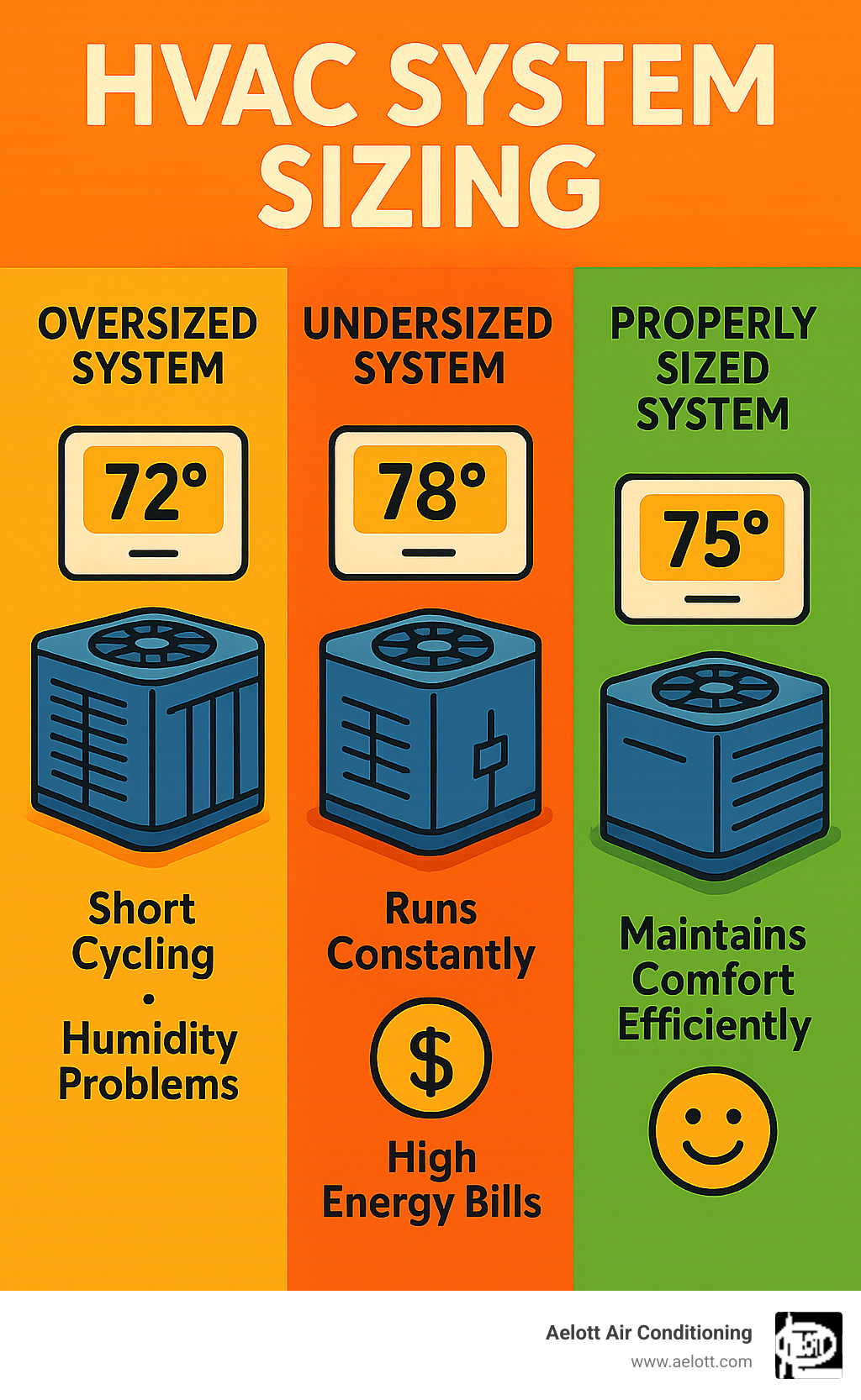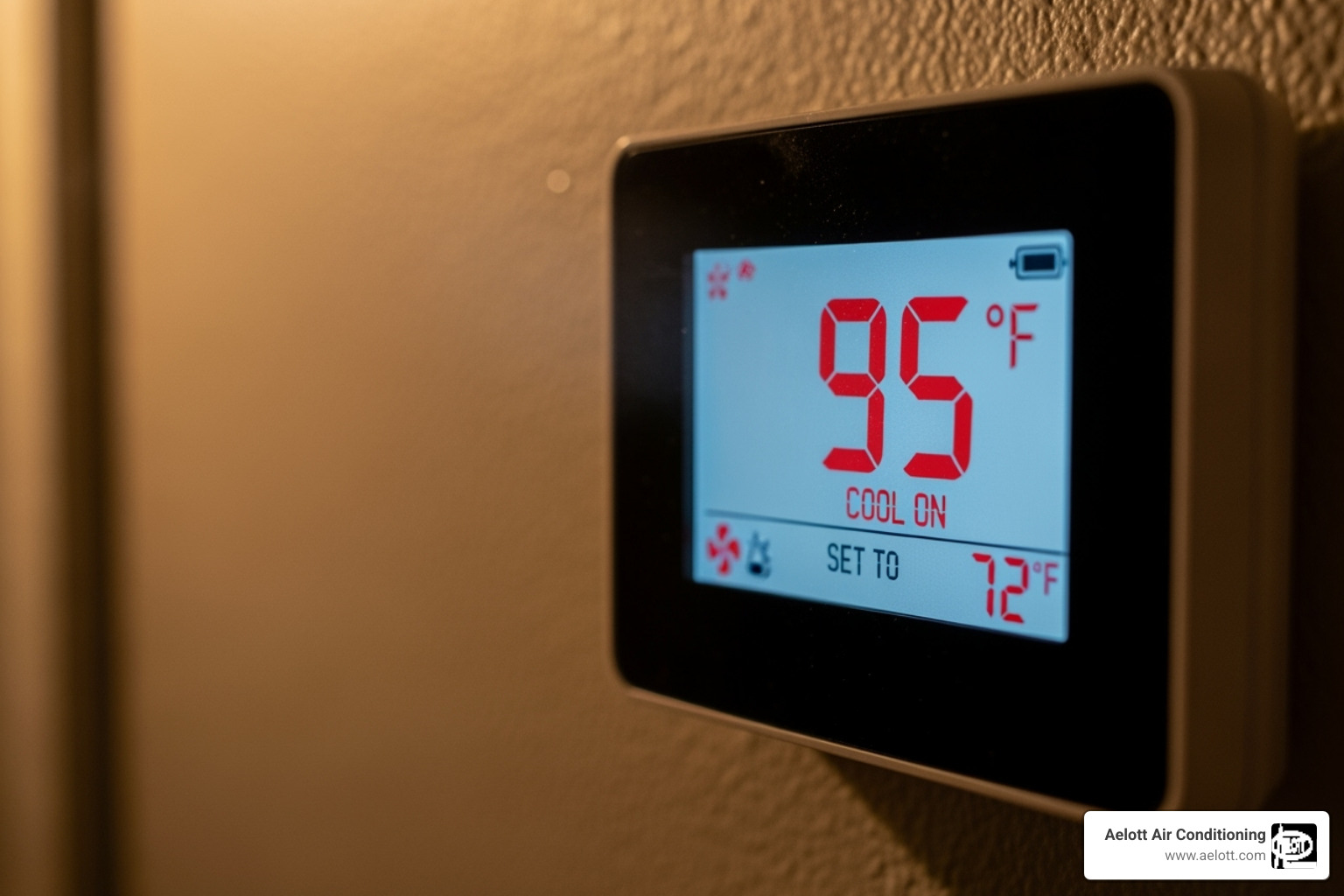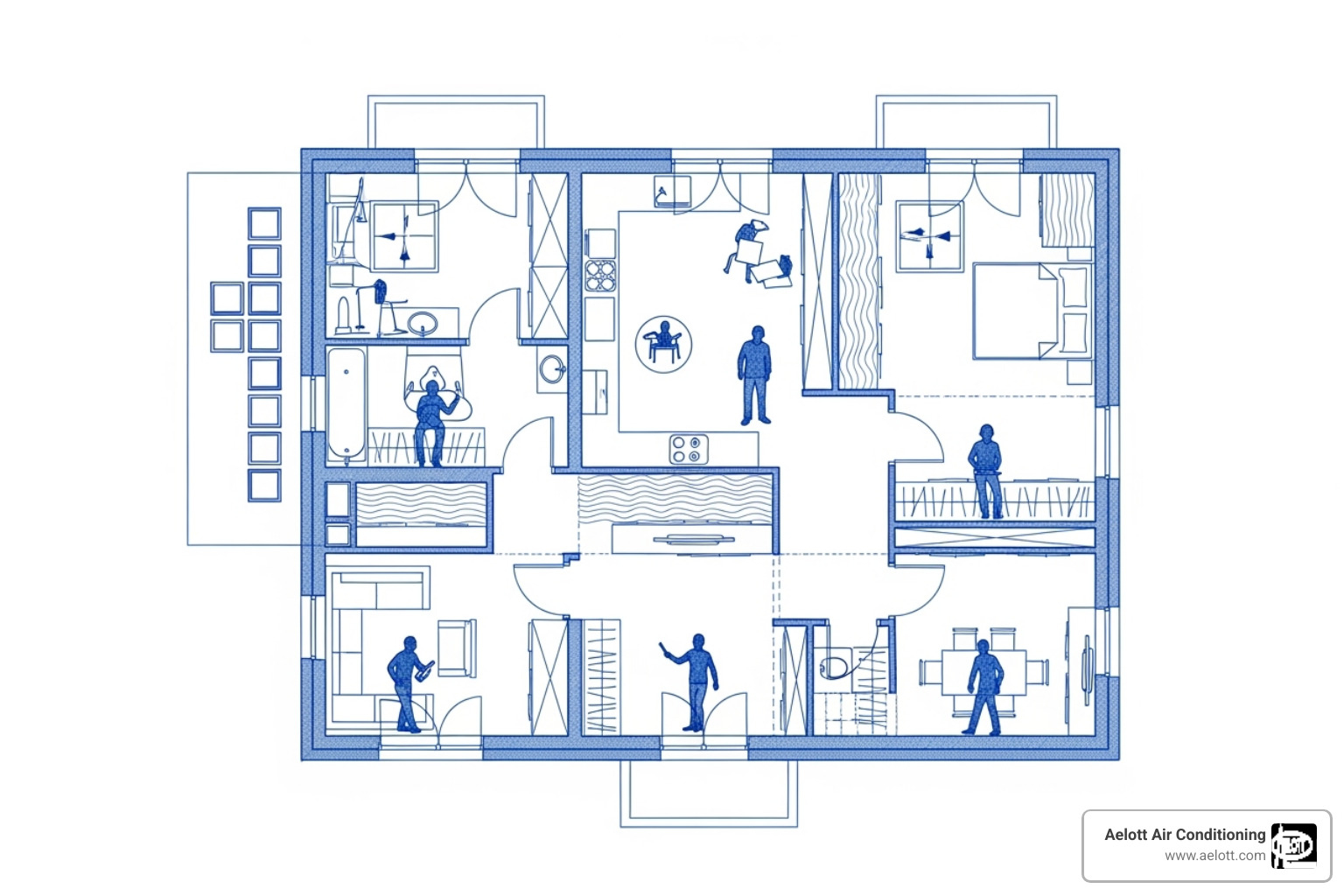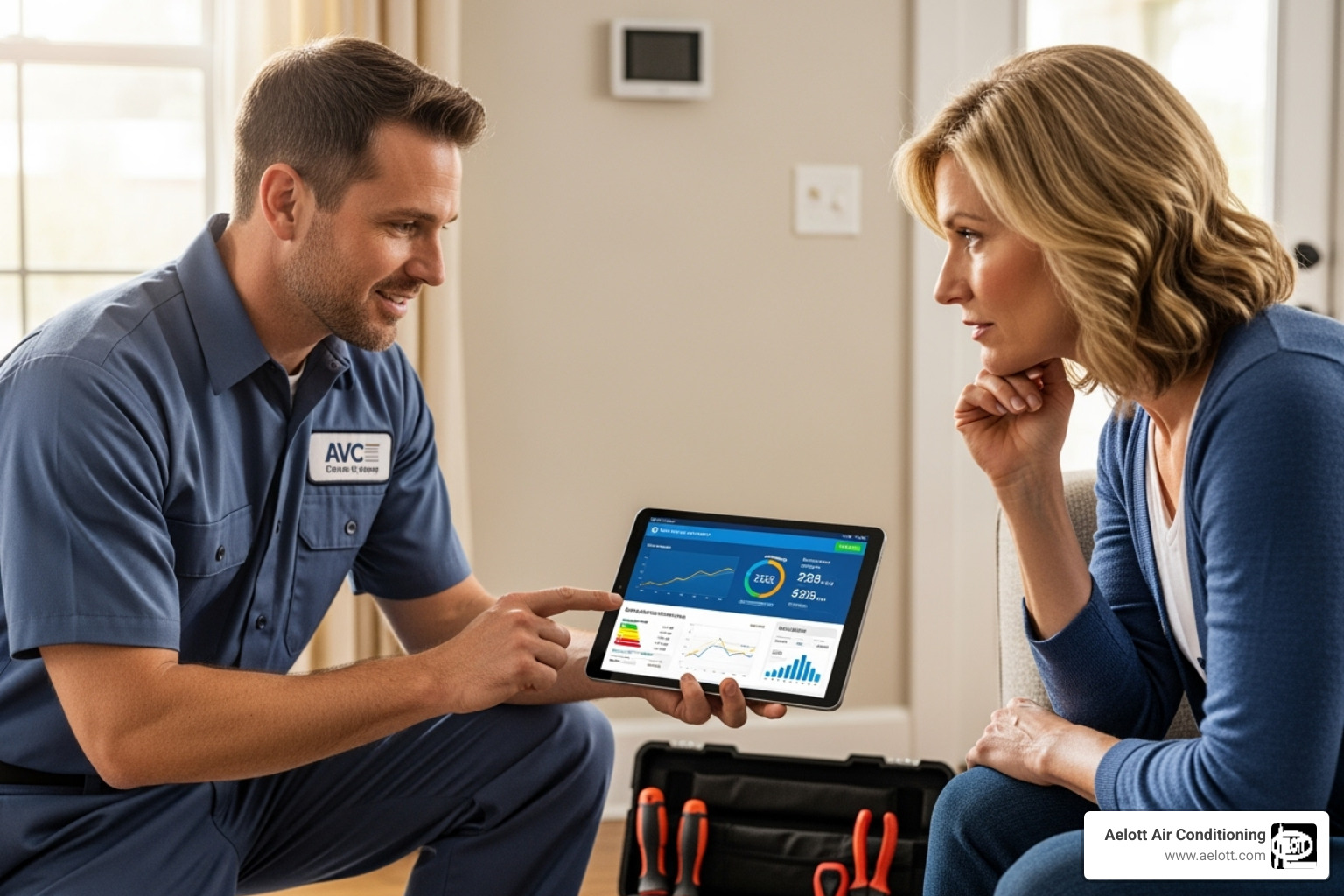.webp)
.webp)
Don't Get Blown Away: A Guide to Perfect HVAC Sizing
Get perfect hvac system sizing for comfort & savings. Avoid costly mistakes & boost efficiency. Learn how!

Why HVAC System Sizing Can Make or Break Your Home Comfort
HVAC system sizing is the process of calculating the exact heating and cooling capacity your home needs to maintain comfortable temperatures efficiently. Here's what you need to know:
Key HVAC Sizing Basics:
- Measured in BTUs (British Thermal Units) and tons of cooling
- 1 ton = 12,000 BTUs of cooling capacity
- Requires professional calculation using Manual J load calculations
- Considers multiple factors beyond square footage alone
- Prevents costly problems like short cycling and high energy bills
Getting your HVAC system size wrong isn't just uncomfortable - it's expensive. Up to 90% of HVAC systems are improperly sized or installed, according to industry estimates. This staggering statistic means most homeowners are dealing with systems that either can't keep up with demand or waste energy cycling on and off constantly.
When contractors use outdated "rules of thumb" like the traditional 600 square feet per ton, they often miss critical factors that affect your home's heating and cooling needs. Modern homes with better insulation may only need 1,000 square feet per ton, while older homes might require more capacity.
The consequences of improper sizing go far beyond discomfort. An oversized system will cool your home quickly but shut off before removing humidity, leaving you feeling sticky and potentially creating conditions for mold growth. An undersized system will run constantly, driving up energy bills while never quite reaching your desired temperature.
Professional sizing considers your climate zone, insulation levels, window types, home orientation, and even the number of occupants. It's not just about keeping you comfortable - it's about doing so efficiently while protecting your investment in HVAC equipment that can last 15-20 years when properly sized and installed.

Why 'Just Right' Matters: The Dangers of Improper Sizing

Think of HVAC system sizing like buying shoes - too big and you'll trip over yourself, too small and you'll be miserable all day. When your heating and cooling system isn't sized just right for your home, it creates a domino effect of problems that hit both your comfort and your wallet.
The biggest culprit behind sizing problems is something called short cycling. This happens when your system kicks on, quickly brings your home to the right temperature, then shuts off again. While that might sound efficient, it's actually terrible for your equipment. All that starting and stopping puts enormous stress on your system's components, kind of like revving your car engine at every red light.
This constant on-off cycle doesn't just wear out your equipment faster - it also leads to energy waste and those dreaded high utility bills. Your system never gets a chance to run efficiently, so it gobbles up electricity or gas without giving you the comfort you're paying for. Over time, all this wear and tear significantly shortens your equipment's lifespan, meaning you'll be shopping for a replacement years sooner than you should.
The Problem with Oversizing
Here's something that surprises many homeowners: bigger isn't always better when it comes to HVAC systems. An oversized system might cool your house quickly, but it shuts off before it has time for proper humidity removal. The result? That uncomfortable clammy feeling where the air feels sticky even though your thermostat says it's the right temperature.
This humidity problem isn't just annoying - it can lead to serious issues like mold and mildew growth throughout your home. Nobody wants to deal with black spots on their walls or that musty smell that just won't go away. Poor indoor air quality from excess moisture can even trigger allergies and respiratory problems for your family.
On top of the comfort issues, oversized systems are guilty of wasted energy and higher installation costs. You're literally paying more money upfront for a system that performs worse than a properly sized one. It's like buying a semi-truck to commute to work - expensive, inefficient, and completely unnecessary.
The Problem with Undersizing
On the flip side, an undersized system is like asking a compact car to tow a boat - it's going to try its best, but it's just not up to the task. These systems run in constant operation, desperately trying to reach your thermostat's set temperature but never quite getting there.
You'll notice uneven cooling throughout your home, with some rooms feeling like saunas while others are merely uncomfortable. The system puts itself under excessive strain as components work overtime, leading to breakdowns and repairs. Meanwhile, your energy bills keep climbing because the system never gets to rest.
During hot summer days or cold winter nights, an undersized system simply gives up the fight. You might find yourself constantly adjusting the thermostat or running fans to try to get comfortable. If your system is struggling like this, it's time to have a professional take a look - and our team provides expert HVAC Repair Escondido CA to get things back on track.
The bottom line? Proper HVAC system sizing isn't just about comfort - it's about protecting your investment and keeping your family happy year-round.
The Building Blocks of Sizing: Key Factors and Measurements

Think of your home as a living, breathing organism. Every window, wall, and appliance plays a role in how much heating and cooling it needs. That's why accurate HVAC system sizing requires us to look at your home's complete picture, not just count up the square footage and call it a day.
Your home has what we call a building envelope – basically the shell that keeps the outside world from becoming your inside world. This includes your roof, walls, foundation, windows, and doors. The quality of this envelope makes a huge difference in how hard your HVAC system has to work.
We also need to understand the internal loads and external loads your home deals with. Internal loads come from inside your home – think people, pets, appliances, and that teenager who takes hour-long showers. External loads come from outside factors like blazing summer sun or bitter winter winds. By calculating your home's heat gain (how much heat sneaks in) and heat loss (how much comfort escapes), we can pinpoint exactly what size system will keep you comfortable.
Beyond Square Footage: Critical Sizing Factors
Your home's square footage is just the starting point for proper HVAC system sizing. Here's what really matters when we're sizing your system:
Your climate zone sets the stage for everything. A home in Phoenix faces completely different challenges than one in San Diego, even if they're identical twins otherwise. We need to know your area's temperature extremes and typical humidity levels.
Insulation R-value tells us how well your home resists heat flow. Better insulation means your HVAC system doesn't have to work as hard. It's like the difference between wearing a thin jacket versus a thick winter coat – the better the insulation, the less energy you need to stay comfortable.
Window type and quantity can make or break your energy efficiency. Single-pane windows are energy vampires, while modern double or triple-pane windows with Low-E coatings are much kinder to your utility bills. We also look at how many windows you have and which direction they face.
Home orientation matters more than you might think. A house with lots of south-facing windows will soak up sun all day, while a north-facing home stays naturally cooler. We factor in how much direct sunlight hits your home throughout the day.
Air infiltration is just a fancy way of saying "leaks." Every crack around a window, gap under a door, or hole where utilities enter your home lets conditioned air escape and outside air sneak in. It's like trying to fill a bucket with holes in it.
Ceiling height affects the volume of air we need to heat or cool. Vaulted ceilings might look gorgeous, but they create a bigger space that requires more capacity than standard 8-foot ceilings.
The number of occupants and their lifestyle adds to your home's heat load. People generate heat and humidity just by being alive, and activities like cooking, showering, and doing laundry all contribute to what your HVAC system needs to handle.
Finally, heat-generating appliances like ovens, refrigerators, computers, and even light bulbs add heat to your home. Modern energy-efficient appliances help, but we still need to account for their contribution.
Understanding the Lingo: BTUs and Tons
When we talk about HVAC system sizing, we use some industry terms that might sound confusing at first, but they're actually pretty straightforward.
British Thermal Units (BTUs) measure energy – specifically, the amount of heat needed to raise one pound of water by one degree Fahrenheit. In HVAC terms, we talk about BTUs per hour, which tells us how much heating or cooling power a system can deliver. A 30,000 BTU furnace can add that much heat to your home every hour. You can learn more about BTUs here: What are British thermal units (Btus)?
Tons of cooling has nothing to do with how much your air conditioner weighs (thankfully!). This term comes from the old days when people used actual ice to cool buildings. One ton equals 12,000 BTUs of cooling capacity per hour. So when we say you need a 3-ton air conditioner, we're talking about 36,000 BTUs of cooling power. Most homes need anywhere from 1.5 to 5 tons of cooling.
We also distinguish between sensible load and latent load. Sensible load is the dry heat that affects air temperature – what you feel when you step outside on a hot day. Latent load deals with humidity – that sticky feeling that makes 75 degrees feel miserable. A properly sized system handles both types of heat to keep you truly comfortable.
SEER ratings measure efficiency, not capacity. Think of SEER like miles per gallon for your car – a higher SEER means the unit uses less energy to deliver the same cooling power. But just like a fuel-efficient car still needs to be the right size for your family, you still need the correct BTUs regardless of the SEER rating.
The Professional Approach to HVAC System Sizing

Here's the truth: your neighbor's uncle's "one ton per 600 square feet" rule isn't going to cut it anymore. Those outdated rules of thumb might have worked decades ago when homes were built like sieves, but today's homes are different. Modern construction techniques, better insulation, and energy-efficient windows have completely changed the game.
Another common mistake we see is nameplate sizing - simply looking at your old unit's model number and ordering the same size replacement. This approach assumes your original system was correctly sized, which, given that up to 90% of systems are improperly sized, is a pretty risky bet. Your 20-year-old oversized air conditioner doesn't deserve a clone!
This is exactly why professional calculations are so important. We don't guess, estimate, or use shortcuts. We measure, calculate, and verify. When you're ready for a new system, this detailed approach ensures you get exactly what your home needs. For homeowners considering a replacement, our team provides expert HVAC Installation Vista CA services that start with proper sizing.
The Gold Standard for hvac system sizing: Manual J
When it comes to accurate HVAC system sizing, there's only one method that truly delivers: the Manual J load calculation from the Air Conditioning Contractors of America (ACCA). Think of it as a comprehensive physical exam for your home's heating and cooling needs.
This isn't a quick walk-through with a clipboard. A proper Manual J involves room-by-room calculations that consider every factor we discussed earlier. We measure window areas, check insulation levels, note ceiling heights, and even account for how many people typically occupy each space. Each room gets its own detailed analysis because your sunny master bedroom has very different needs than your basement family room.
The magic happens when we combine all these individual room calculations into a whole-house load assessment. Modern software calculations help us process all this data accurately, but the quality depends entirely on the detailed measurements and observations we input. It's like cooking - even the best recipe won't work if you don't measure the ingredients properly.
You might find online calculators that promise quick results, but they simply can't capture the nuances that a professional Manual J reveals. Want to understand more about what goes into these calculations? Check out this helpful resource: What is a Manual J calculation?
From Calculation to Equipment: Manual S, D, and System Type
Once we know exactly how much heating and cooling your home needs, the next step is Manual S (Equipment Selection). This is where we match real equipment to your calculated loads. Not all "3-ton" units are created equal - different manufacturers have slightly different actual capacities, and we need to ensure the equipment we select truly matches your home's needs.
But even the perfectly sized equipment won't work properly without the right delivery system. That's where Manual D (Duct Design) comes in. Your ducts are like the circulatory system of your home - they need to be properly sized and sealed to deliver the right amount of conditioned air to each room.
The type of system you choose affects the entire sizing process. Split systems are the most common setup, with an outdoor unit connected to an indoor unit through ductwork. We need to ensure both components work together harmoniously. Ductless mini-splits offer room-by-room control and are perfect for homes without existing ducts or for specific zones that need extra attention. Packaged units house everything in one outdoor cabinet, which simplifies installation but still requires the same careful load calculations.
Your ductwork condition plays a huge role in system performance. Even perfectly sized equipment can't overcome leaky, undersized, or poorly designed ducts. We evaluate your existing ductwork as part of the sizing process because there's no point in installing a precision-sized system if half the conditioned air leaks out before it reaches your rooms.
The professionals at ACCA have spent decades perfecting these methods, and their standards represent the best practices in our industry. You can learn more about their comprehensive approach here: Learn more from the Air Conditioning Contractors of America
Ensuring Accuracy: Your Role in a Perfect Installation
Be a partner in getting your HVAC system sizing right. Your involvement makes the difference between a system that just works and one that works perfectly for your home and lifestyle. Since up to 90% of systems are improperly sized or installed, being an informed homeowner is your best protection. You know your home's unique quirks—which rooms get too hot, where drafts come from, and how your family lives in the space. This knowledge is vital for accurate sizing, and the best contractors will want these details.
Regular maintenance also plays a huge role in keeping your properly sized system running efficiently. If you're in the San Marcos area and want to keep your system in peak condition, check out our HVAC Tune-Up San Marcos CA services.
Common Mistakes to Avoid in HVAC System Sizing
To ensure a proper fit, avoid these common pitfalls:
- Ignoring recent home improvements. If you've added insulation or replaced windows, your home's heating and cooling needs have changed. Don't let a contractor size a new system based on your old, leaky house.
- Using outdated rules of thumb. Formulas like one ton of cooling per 400-600 square feet are relics. Modern homes are far more efficient, and your system size must reflect that.
- Not accounting for duct leakage. Leaky ducts force your system to work much harder. A good contractor will assess your ductwork condition before sizing new equipment.
- Choosing the cheapest bid without checking the work. A dramatically lower bid often means the contractor is skipping essential steps, like proper load calculations. Ask why it's so low.
- Falling for the "bigger is better" myth. An oversized system is inefficient, makes you uncomfortable, and wastes energy. Trust the math, not the marketing.
How to Vet Your HVAC Contractor's Work
A trustworthy contractor will welcome your questions. Start by asking about their Manual J load calculation approach—it's the foundation of proper sizing. If they use "experience" instead, keep looking.
Request a copy of the Manual J report to see that they've accounted for your home's specific features, like insulation, windows, and climate data. Ask if they recommend a blower door test to measure air leakage, as this shows a thorough approach. You can learn more about these assessments at Learn about home energy assessments.
Finally, make sure everything is in a written contract, including equipment specs, load calculation results, and warranty details. Don't hesitate to get a second opinion if something feels off. A good contractor will be confident in their work.
Frequently Asked Questions about HVAC Sizing
We get a lot of questions from homeowners who want to understand HVAC system sizing better. After decades in the business, we've noticed the same concerns come up again and again. Let's tackle the big ones that keep you up at night (hopefully not because your HVAC system isn't working properly!).
How do I know what size my current HVAC unit is?
The easiest way is to play detective with your outdoor unit. Look for the data plate or nameplate - it's usually a metal sticker somewhere on the condenser unit outside your home. The model number is your treasure map here.
You'll often see numbers embedded in that model number that tell the story. For example, if you spot a "36" in there, that typically means 36,000 BTUs, which translates to a 3-ton unit. A "48" would indicate 48,000 BTUs or a 4-ton system. It's like a secret code once you know how to crack it!
Can't find the plate, or does it look like it went through a weather battle and lost? No worries - any qualified HVAC technician can determine your system's capacity during a quick inspection. We do this all the time during service calls.
Can I use an online calculator for HVAC sizing?
Online calculators are tempting - they're free, fast, and available at 2 AM when you're researching your next HVAC purchase. But here's the thing: they're about as reliable as using a ruler to measure the ocean.
These calculators can give you a rough ballpark estimate, which is fine for initial curiosity. But they're missing so many critical pieces of your home's unique puzzle. They don't know about that amazing insulation job you had done last year, or those beautiful new energy-efficient windows, or how your house sits on the lot. They can't account for air leakage, your specific climate zone, or even how many people live in your home.
Think of online calculators as a quick snapshot, not a professional portrait. They might tell you you're in the 3-ton range, but they can't tell you if you need 2.5 tons or 3.5 tons - and that difference matters enormously for your comfort and energy bills. HVAC system sizing requires the precision of a professional Manual J calculation to get it right.
Does a high-efficiency (SEER) unit change the size I need?
This is one of the most common mix-ups we see, and it makes perfect sense why people get confused. Here's the key: efficiency and size are completely different animals, even though they both affect your energy bills.
SEER (Seasonal Energy Efficiency Ratio) tells you how efficiently your unit operates - think of it as your system's gas mileage. A higher SEER rating means the unit uses less electricity to produce the same amount of cooling. So a 3-ton, 20 SEER unit will use significantly less energy than a 3-ton, 14 SEER unit, but both still deliver exactly 36,000 BTUs of cooling capacity.
Your home doesn't care how efficiently the cooling is produced - it still needs the same amount of cooling to stay comfortable. A 2,000 square foot home with specific insulation, windows, and orientation needs a certain number of BTUs to maintain 72°F, whether that cooling comes from a basic unit or a super-efficient model.
The bottom line? You still need a professional load calculation to determine the right capacity for your space, regardless of how efficient the unit is. Get the size right first, then choose the highest efficiency your budget allows. Your wallet will thank you for both decisions.
Get a Professional Sizing Assessment for Your Home
Getting your HVAC system sizing right isn't just about comfort – it's about protecting one of the biggest investments in your home. When you think about it, your HVAC system will likely run for 15-20 years, quietly working behind the scenes to keep your family comfortable through scorching summers and chilly winters. That's thousands of hours of operation, and every single one of those hours should be as efficient and effective as possible.
The consequences of getting it wrong are real and costly. High energy bills that make you cringe every month. Premature system failure that leaves you scrambling for emergency repairs during the worst possible weather. Poor indoor air quality that affects your family's health and comfort. These aren't just inconveniences – they're expensive problems that proper sizing prevents from the very beginning.
Here's the thing: you shouldn't have to rely on guesswork or outdated rules of thumb when it comes to something this important. Your home is unique, with its own personality, quirks, and needs. A professional assessment takes all of these factors into account, creating a custom solution that works specifically for your space and your family's lifestyle.
At Aelott Air Conditioning, we've been perfecting the art and science of HVAC system sizing since 1963. That's over six decades of helping San Diego County families find their perfect comfort zone. We've seen every type of home, from charming 1950s ranch styles to modern energy-efficient builds, and we know that no two homes are exactly alike.
When you work with us, you're getting more than just calculations on a tablet. You're getting honest pricing, decades of real-world experience, and the peace of mind that comes with our 100% satisfaction guarantee. We don't just size your system – we make sure it's perfectly matched to your home's unique characteristics and your family's comfort preferences.
Whether you need expert HVAC services for a new installation or you're concerned about your current system's performance, we're here to help. Contact us for a comprehensive evaluation that takes the guesswork out of comfort. And if you're dealing with an existing system that just isn't performing right, our team provides dependable HVAC repair in Escondido, CA with the same attention to detail and commitment to excellence.
Your home deserves a system that's sized just right – not too big, not too small, but perfectly matched to keep you comfortable year-round while keeping your energy bills in check.

Customer Testimonials
Go With Experience

HVAC Financing Available!
Get 0% Financing for 12 Months with Deferred Interest! Enjoy no payments and no interest on select plans.


Latest Blogs

.avif)
How to Run Your Furnace Efficiently: A Guide to Staying Warm This Winter







